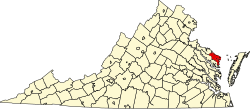Lake | |
|---|---|
| Coordinates: 37°58′27″N76°28′11″W / 37.97417°N 76.46972°W | |
| Country | United States |
| State | Virginia |
| County | Northumberland |
| Time zone | UTC−5 (Eastern (EST)) |
| • Summer (DST) | UTC−4 (EDT) |
Lake is an unincorporated community in Northumberland County, Virginia, United States. Lake is on the Coan River, a tidal tributary of the Potomac River.


